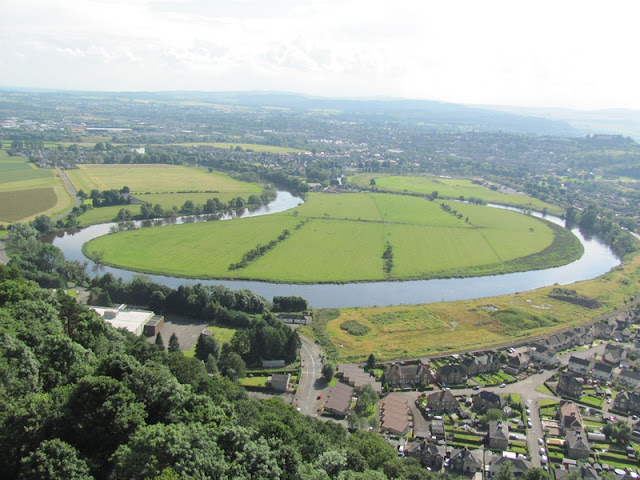As you zoom past it on the motorway or train, Stirling is a distinctive city. Not only does it have an impressive castle sitting prominently on a hill in it's middle (we visited it last year here) but on another hill just outside it it has a rather unique structure which is the National Wallace monument. This picture of it was taken from our campsite a couple of weeks ago.
Here it is from the hill just below it when we went to visit it. By the time of Victoria, the Jacobite rebellions were a distant memory and there was quite a surge in Scottish nationalism. So, through a campaign to raise money by public subscription, this monument was raised to the great Scottish hero William Wallace in 1869. Most of the world know him through the film Braveheart which may be a jolly good film but not the place to go to find out about the man - here's the Wikipedia page for him where you'll find no mention of his face half painted blue.
This is the Wallace sword. It may or may not have belonged to William Wallace (The monument rather fails to mention the "may not" part). It certainly had some connection to Wallace a couple of hundred years after his death when in 1505, James IV had the hilt replaced, suggesting that, what he called the "Wallas sword", had some importance. There are some suggestions that some of the other fittings aren't right for the period and place but they don't remove the possibility that some or all (minus the handle of course) belonged to Wallace.
In a room on the first level of the tower is a collection of busts of other prominent Scottish characters. Here's the other great hero of the Scottish wars of Independence, Robert the Bruce. When he was dying he asked his right hand man, the Black Douglas, to take his heart on crusade, which he did. By some accounts he cast his heart into the midst of a battle crying, "Lead on Braveheart" (sound familiar!).
Four more Scottish types carved in marble. Clockwise; mighty penster and party animal, Mr Robert Burns; missionary and African Explorer, Dr David Livingston (who appeared in the last post too); another mighty penster, the better behaved Sir Walter Scott; and last but not least, good old James Watt who came up with some cracking ideas about steam while making himself a cuppa one morning.
Above the busts are these stained glass windows. Here is Robert the Bruce.
William Wallace and that famous sword.
I don't know who the other two windows are meant to represent - I could see no information.
The design of the Wallace monument, much like the Scott Monument, was result of a competition. The winner was John Thomas Rochead who belonged to Edinburgh. The drawing below was for a sculpture suggested for the competition by Sir Joseph Noel Paterson (also mentioned in the last post). It was suggested that, for all Scotland and England didn't get on all that well in Wallace's days, things were much friendlier in Victorian times when the monument was built and perhaps Sir Joe's entry was a touch inflammatory.
The way to the top of the monument was by a long spiral staircase which I did not like. I've already been up to the top of the Scott monument this year - no more high places this year, I can tell you. There are no pictures of the stairs but here are some pictures of the top.
The view from the top is really cracking. The Battle of Stirling Bridge (a good day for Wallace on 11th of September 1297) happened on this loop of the River Forth.
The campus of Stirling university.
If we could see the monument from the campsite, it stands to reason that the reverse view was possible. Our tent was hidden from view by the trees on the left hand side.
Stirling castle as seen from the monument.
A quick snap over the edge. I didn't look at this when I took it and was quite surprised to see a pile of money had been thrown into the guttering (who would expect that in Scotland)
A view of the tower from the bottom.






















































